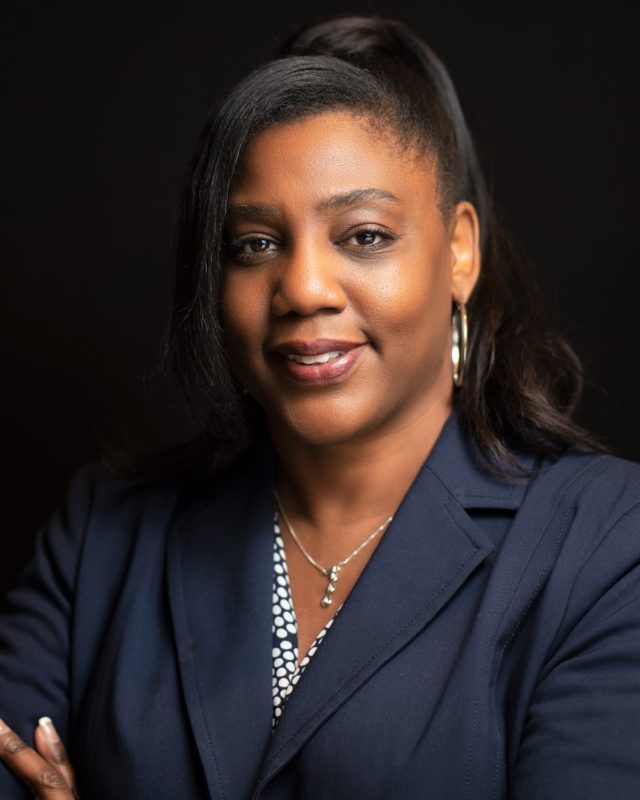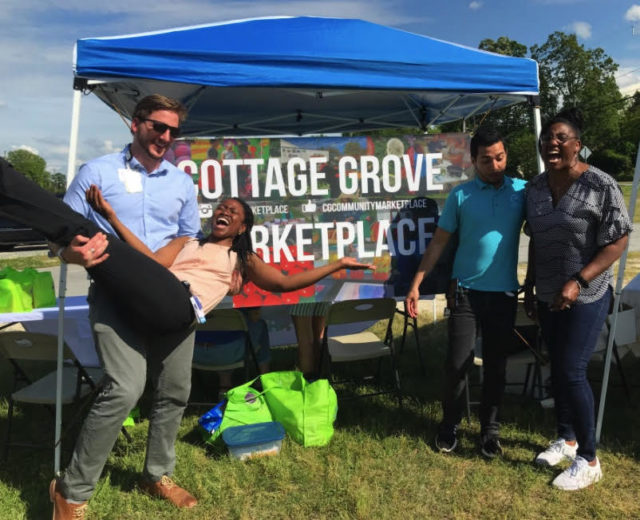This is Part 3 of our series about the work between Cone Health and the Greensboro Housing Coalition. You can also view Part 1 here and Part 2 here.

Trust is the foundation of health equity work. But as is true at Cone Health in Greensboro, North Carolina, cultivating trust with a community your institution has harmed is slow and difficult work. Like laying the foundation of a house, trust is built one brick—or in this case, one action—at a time.
In 2016, a pair of grants presented an opportunity for residents of Cottage Grove, a predominantly Black neighborhood in Southeast Greensboro, to design health equity interventions around one of their top priorities: reducing childhood asthma.
But there was a catch: the grants required that a health system be part of the applications alongside both a community-based organization and a city agency. Cone Health, the local health system, was a logical partner. However, residents remember its history of denying care to Black people during years of health care segregation, and they still feel the effects of how that policy, alongside redlining and other structural disinvestments, shape life in the city today. The grant was an opportunity for residents and organizations across Greensboro to work together and leverage knowledge and resources collectively, but residents were understandably skeptical about whether they could trust the health system as a partner.
These organizations are part of the Cottage Grove Collaborative:
• Greensboro Housing Coalition
• New Hope Community Development Group
• Cottage Grove Neighborhood Association
• Cone Health
• Mt Olivet A.M.E Zion Church
• East Street Market Seventh Day Adventist Church
• Friendly Neighborhood Watch Association
• Triad Adult & Pediatric Medicine
• Mustard Seed Community Health
That lack of trust was something Josie Williams understood. A Black woman and native of Greensboro, she grew up in the residual impact of the city’s long history of segregation and discrimination. Williams also remembers not going to The Moses H. Cone Memorial Hospital for health care as a child, even after the hospital integrated. In 2016, she was hired by the Greensboro Housing Coalition to lead the grant efforts. Her role included facilitating meetings between neighborhood residents and the broad coalition of organizations and agencies as they worked to set goals for the project, determine an approach, and coordinate resources.
It was at one of these meetings where Williams first met Kathy Colville, Cone Health’s then-healthy communities director. Cone Health was at the same time going through its own internal accounting, so the health system had begun looking for ways to get proximate to the community and partner outside hospital walls on forces driving inequities. Colville had started attending neighborhood meetings in Cottage Grove a couple years earlier at the invitation of a local organizer to listen and learn from residents in their space. Williams had never seen a top leader from a health system show up regularly to what at the time was a small gathering of residents who didn’t yet have funding for a project. She was impressed by Colville’s presence and found it meaningful. At the same time, Cone Health’s history also made Williams skeptical. “What’re you gonna help us with?” Williams recalls thinking to herself at the time, “You didn’t even want us in your hospital.”
The coalition eventually won the grants and over two years worked to map and rehabilitate more than 175 substandard housing units in the city, successfully reducing emergency department admissions for childhood asthma. For its part, Cone Health contributed critical data that allowed asthma admissions to be mapped against city housing data. During this work, Colville and later Jamilla Pinder, assistant director of healthy communities at Cone Health, participated in community meetings and served as a bridge between residents and the health system. They carried residents’ priorities back to other leaders at Cone Health and helped to leverage the health system’s resources to support residents’ work. In reflecting on how Colville, Pinder, and Cone Health’s relationship with the community evolved during this project, Williams shared the following lessons.
Five key lessons health systems can use to help cultivate trust
1) Show up where the community is and listen without an agenda
In 2013, three years prior to the formal start of the asthma work, Cottage Grove residents had started organizing to address some of the issues that were contributing to poor health in their neighborhood, including substandard housing, access to health care, and access to healthy food. It was then that Colville first started regularly attending neighborhood meetings to listen to and learn from residents in their space. And throughout the asthma work, Colville and Pinder were a constant presence in community spaces. Meeting with community members where they live may seem like a simple and obvious step, but it is often neglected. Williams noted, “I don’t think people understand how powerful that is just for residents to see you show up and you are the decision maker.”
Equally important is showing up with humility and without an agenda. Early on, Williams told Colville, “You guys have to acknowledge the reality that this health system contributed to segregation and take ownership of that. Just listen and provide support. Don’t come in here asking for nothing. They’re not here for you. You’re supposed to be there for them. I remember her receiving it and understanding, and that right there got my attention.”
2) Stay engaged, especially when it gets hard
There was a point early on when Williams was facilitating conversations between Cottage Grove residents and coalition partners, and residents disagreed heatedly with another healthcare provider (not Cone Health) about what its priorities should be. Williams remembers that Colville got quiet and then didn’t show up at meetings for a while afterward. At that point, Colville and Williams had developed a strong relationship, so Williams took a chance and reached out to remind Colville that her presence and voice were powerful, and that she needed to keep showing up. Colville thanked Williams for calling her back in. She came to the very next meeting, and she kept coming back. It was a pivotal moment in the relationship. It’s also a reminder of the risk facilitators like Williams take on in work like this, trying to maintain the trust of residents while also extending a hand to the institutions where trust is trying to be built.

3) Carry the community’s message into your institution and return with resources
Building trust with large institutions often starts with building trust in specific individuals—the ones who are showing up in the community—but it can’t end there. Those individuals have to serve as bridges for action and accountability from the larger institution. One of the most important things Colville and Pinder did was consistently build support for the work residents were doing with other leaders inside Cone Health, becoming a connection point between Cottage Grove and the larger health system. “That’s what health systems miss when they’re trying to engage in racial equity work and change in their system and in the community,” said Williams. “You need someone constantly having that conversation internally, and the best way that you can engage is just be present.”
Most important, Colville and Pinder urged Cone Health to dedicate tangible resources to the asthma project—first letters of support for the grant, then in-kind support, and later cash support. They were also instrumental in getting community members access to de-identified trend data from the health system to support other grassroots health equity initiatives, something community groups had been fighting unsuccessfully to get access to for years.
4) Prioritize community voice in decision-making, planning, and implementation
Part of what made the work in Cottage Grove effective was that it was residents who raised and prioritized the issue around asthma and its connection to substandard housing, and it was built on the back of years of community organizing. Cone Health, the city’s public health department, and other organizations made vital contributions, but it was all in response to a need identified by the community. And just like listening, following the community’s lead is an important part of building trust.
Williams emphasized the importance of having people with lived experiences in the room for any discussion about how to advance health equity, and that agendas should be built collaboratively in ways that prioritize community voice in decision-making, planning, and implementation. She warned to not lose sight of this piece as time goes on. “As successes happen and collaboration gets stronger, there comes an opportunity for those [in institutions] to say, ‘Oh, we don’t have time to ask the communities A, B, C, or D,’” she said. “They can forget that none of the successes happened without those residents. But that’s the sustainable piece.”

5) Continue to work together, even when a specific project is over
The coalition’s work led to tangible improvements in housing and asthma admissions. Equally important, the relationships developed during this work have continued to grow and spark new collaborations. All of Cone Health’s medical residents now learn about the history of redlining in Greensboro and go to Cottage Grove to learn a little bit about the realities their patients face. Pinder continues to attend resident meetings in Cottage Grove (Colville has since left Cone Health), and she continues to carry what she learns there back to the health system. For example, she was a major force pushing the health system to get a mobile community clinic into Cottage Grove for COVID testing during the pandemic after residents said they couldn’t get to the only testing locations in the city’s center.
Building trust between Cone Health and residents in Greensboro is an ongoing process that didn’t begin or end with the work in Cottage Grove. But each action taken builds on the last, slowly creating a foundation, brick by brick. Show up and listen. Stay when it’s hard. Follow a community’s lead. Deploy resources. And repeat, understanding that the work—of both advancing health equity and building trust—doesn’t end when a project does.
Featured Content
Staff Spotlight: Erica Jones, Following Her Path and Passion to Help People
“I wish people would try to advocate for themselves more, because I feel like there's this power struggle and people don't feel like they can.”
Staff Spotlight: Kyron Pierce, The Eagle Scout with a Passion For Helping People Lead Healthy Lives
“[Health equity] is very hard work and it might be some years for us to see the fruits of our labor, but it'll be worth it when you do produce it.”
Staff Spotlight: Alejandra Cabrera, Perfectly Imperfect Artist and Health Equity Advocate
When I work with people and communities, I always think back to this sense of not belonging and it drives me to continue to do the heart-work we need to do to advance health equity.


